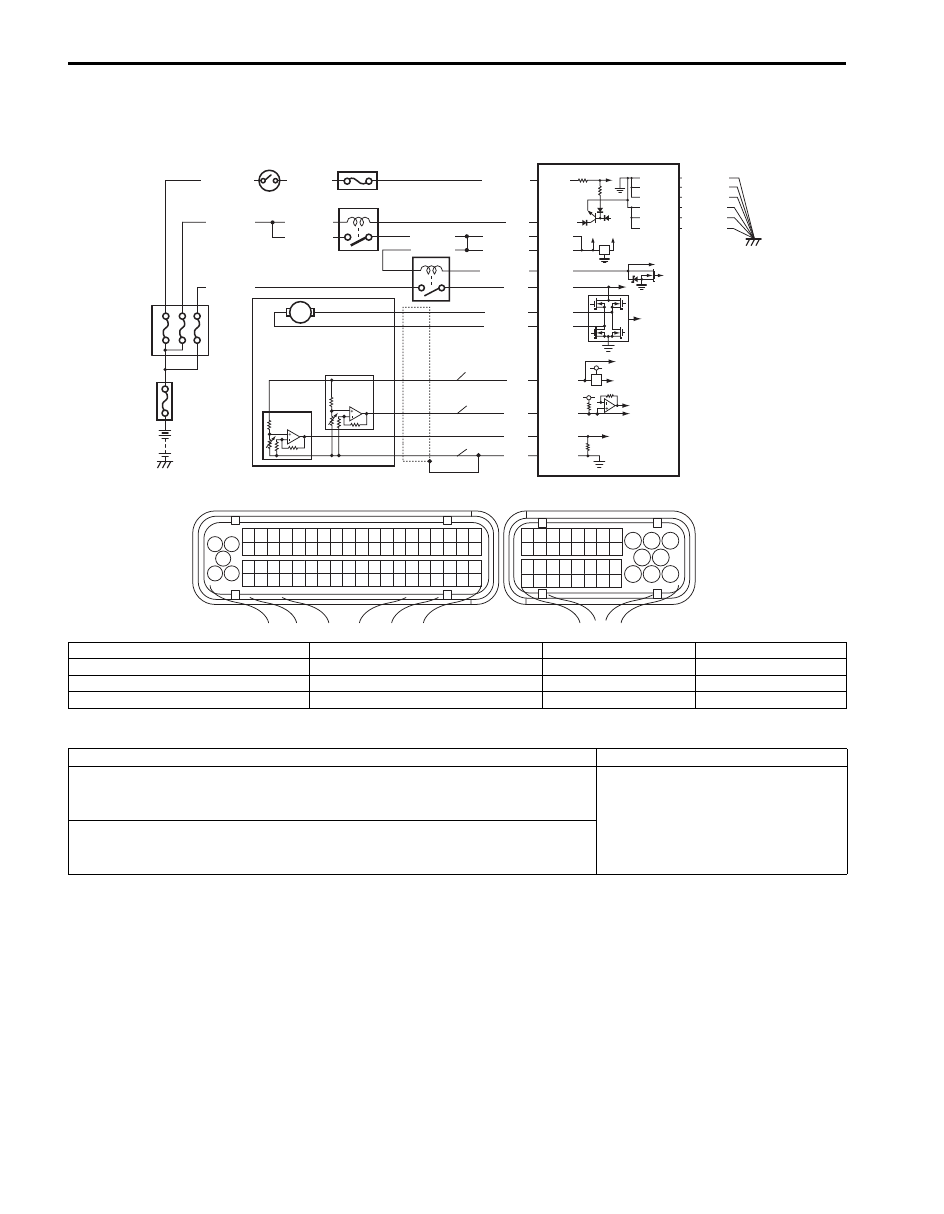Suzuki Grand Vitara JB627. Manual — part 40

1A-109 Engine General Information and Diagnosis:
DTC Confirmation Procedure
WARNING
!
• When performing a road test, select a place where there is no traffic or possibility of a traffic
accident and be very careful during testing to avoid occurrence of an accident.
• Road test should be carried out with 2 persons, a driver and a tester, on a level road.
NOTE
Check to make sure that the following conditions are satisfied when using this “DTC Confirmation
Procedure”.
• Intake air temperature: –10
°C (14 °F) to 80 °C (176 °F).
• Engine coolant temperature: 30
°C (86 °F) or more.
• Altitude (barometric pressure): 2400 m, 8000 ft or less (560 mmHg, 75 kPa or more).
• The following DTC is not detected: ECT sensor, CKP sensor, IAT sensor, MAP sensor, A/F sensor, A/
F sensor heater, TP sensor, barometric pressure sensor, MAF sensor, EGR system and CMP sensor.
1) With ignition switch OFF, connect scan tool.
2) Turn ON ignition switch and clear DTC using scan tool.
3) Start engine and warm up to normal operating temperature.
4) Drive vehicle at 40 mph (60 km/h) or higher. (engine speed: 2500 – 3000 r/min.)
5) Keep above vehicle speed for 4 min. or more. (Throttle valve opening is kept constant in this step.)
6) Check if DTC and pending DTC exist by using scan tool. If not, check if oxygen sensor monitoring test has been
completed by using scan tool. If not in both of above checks (i.e., no DTC and pending DTC and oxygen sensor
monitoring test not completed), check vehicle condition (environmental) and repeat Step 3) through 6).
DTC Troubleshooting
NOTE
Before this trouble shooting is performed, read the precautions for DTC troubleshooting referring to
“Precautions for DTC Troubleshooting”.
Step
Action
Yes
No
1
Was “Engine and Emission Control System Check”
performed?
Go to Step 2.
Go to “Engine and
Emission Control
System Check”.
2
Intake system and exhaust system for leakage check
1) Check intake system and exhaust system for leakage.
Are intake system and exhaust system in good condition?
Go to Step 3.
Repair or replace
defective parts.
3
Fuel pressure check
1) Check fuel pressure referring to “Fuel Pressure Check”.
Is check result satisfactory?
Go to Step 4.
Repair or replace
defective parts.
4
Fuel injectors and its circuit check
1) Check fuel injectors referring to “Fuel Injector Inspection
Is check result satisfactory?
Go to Step 5.
Faulty injector(s) or its
circuit.
5
MAF sensor visual inspection
1) Check MAF sensor and air intake system.
• Objects which block measuring duct and resistor of
MAF sensor.
• Other air flow which does not pass MAF sensor.
Are they in good condition?
Go to Step 6.
Repair or replace
defective part.

Engine General Information and Diagnosis: 1A-110
6
MAF sensor for performance check
1) With ignition switch turned OFF, connect scan tool to
DLC.
2) Start engine and warm up to normal operating
temperature.
3) Check MAF value using scan tool (Refer to “Scan Tool
Data” for normal value.).
Is each value within specified range?
Go to Step 7.
Go to “DTC P0101:
Mass Air Flow Circuit
Range / Performance”.
7
A/F sensor adjusting resistor circuit check
1) Disconnect connectors from A/F sensor (bank-2) and
ECM with ignition switch turned OFF.
2) Check for proper terminal connection to A/F sensor
(bank-2) connector and ECM connector.
3) If connections are OK, check that A/F sensor (bank-2)
adjusting resistor circuit is as follows.
• Wiring harness resistance of each “Adjusting resistor
(+) circuit of A/F sensor (bank-2)” and “Adjusting
resistor (–) circuit of A/F sensor (bank-2)” is less than
1
Ω.
• Insulation resistance between “Adjusting resistor (+)
circuit of A/F sensor (bank-2)” wire terminal and
vehicle body ground is infinity.
• Insulation resistance between “Adjusting resistor (+)
circuit of A/F sensor (bank-2)” and “Adjusting resistor
(–) circuit of A/F sensor (bank-2)” is infinity.
• Circuit voltage between “Adjusting resistor (+) circuit
of A/F sensor (bank-2)” and vehicle body ground is 0
V with ignition switch tuned ON.
Are they in good condition?
Go to Step 8.
Repair or replace
defective wiring
harness.
8
A/F sensor adjusting resistor check
1) Check for resistance of A/F sensor (bank-2) adjusting
resistor referring to “Air Fuel Ratio (A/F) Sensor On-
Vehicle Inspection in Section 1C”.
Is check result satisfactory?
Go to Step 9.
Replace A/F sensor
(bank-2).
9
Valves and valves clearance check
1) Check bank-2 intake & exhaust valve and valve
clearance referring to “Valve Lash (Clearance)
Inspection in Section 1D” and “Valves and Valve Guides
Inspection in Section 1D”.
Is check result satisfactory?
Substitute a known
good ECM and recheck.
If ECM OK, replace A/F
sensor (bank-2).
Repair or replace
defective parts.
Step
Action
Yes
No

1A-111 Engine General Information and Diagnosis:
DTC P0222 / P0223: Throttle Position Sensor (Sub) Circuit Low/High
S6JB0B1104036
Wiring Diagram
DTC Detecting Condition and Trouble Area
DTC Confirmation Procedure
1) With ignition switch turned OFF, connect scan tool.
2) Turn ON ignition switch and clear DTC by using scan tool if any.
3) Start engine and it for 10 seconds.
4) Check DTC by using scan tool.
BLU/BLK
BLU/BLK
BLU/BLK
BLK/RED
BLK/RED
BLK/RED
BLU
12V 5V
E23-8
E23-16
E23-2
E23-3
WHT/GRN
C37-59
C37-58
C37-39
C37-73
C37-80
BLK/YEL
BLK/ORN
BLK/ORN
BLK/YEL
BLK/YEL
1
3 2
4
5
6
7
8
9
1110
12
13
14
15
16
17
18
19
20
17
18
19
20
21
22
23
24
25
26
27
28
29
30
31
33
34
35
36
37
38
39
40
32
1
2
3
4
5
6
7
8
9
10
11
12
13
14
15
16
21
22
23
24
25
26
27
28
29
30
31
32
33
34
35
36
37
38
39
40
41
42
43
44
45
46
47
48
49
50
51
52
53
54
55
56
57
58
59
60
61
62
63
64
65
66
67
68
69
70
71
72
73
74
75
76
77
78
79
80
81
E23
C37
BLK/ORN
C37-81
BLK/YEL
BLK/WHT
BLU/ORN
GRN
BLU/YEL
BLU/RED
BLU/BLK
E23-6
E23-7
E23-5
E23-4
C37-45
C37-46
C37-65
C37-64
BLU/RED
WHT
GRN
RED
BLK
P
S
G
8
11 10 9
13
12
7
5
2
1
4
3
6
I6JB01110034-02
P: TP sensor power supply circuit
2. Throttle actuator
6. ECM
10. “FI” fuse
S: TP sensor (sub) signal circuit
3. Throttle position sensor (main)
7. Main relay
11. “IGN” fuse
G: TP sensor ground circuit
4. Throttle position sensor (sub)
8. Fuse box No.2
12. “IG COIL” fuse
1. Electric throttle body assembly
5. Throttle actuator control relay
9. “THR MOT” fuse
13. Ignition switch
DTC detecting condition
Trouble area
DCT P0222: Throttle Position Sensor (Sub) Circuit Low
Output voltage of TP sensor (sub) is less than 0.55 V.
(1 driving cycle detection logic)
• TP sensor (sub) circuit
• Electric throttle body assembly
• ECM
DCT P0223: Throttle Position Sensor (Sub) Circuit High
Output voltage of TP sensor (sub) is more than 4.82 V.
(1 driving cycle detection logic)

Engine General Information and Diagnosis: 1A-112
DTC Troubleshooting
NOTE
• Before this trouble shooting is performed, read the precautions for DTC troubleshooting referring to
“Precautions for DTC Troubleshooting”.
• When DTC P0122 and P0222 are indicated together, it is possible that TP sensor power supply
circuit is open.
• When DTC P0123 and P0223 are indicated together, it is possible that TP sensor power supply
circuit is shorted to power circuit and/or TP sensor ground circuit is open.
Step
Action
Yes
No
1
Was “Engine and Emission Control System Check”
performed?
Go to Step 2.
Go to “Engine and
Emission Control
System Check”.
2
TP sensor and its circuit check
1) Connect scan tool to DLC with ignition switch turned
OFF.
2) Turn ON ignition switch, check “TP Sensor 2 Volt”
displayed on scan tool when accelerator pedal is idle
position and fully depressed.
Is displayed TP sensor value as described voltage in “Scan
Tool Data”?
Intermittent trouble.
Check for intermittent
referring to “Intermittent
and Poor Connection
Inspection in Section
00”.
Go to Step 3.
3
Wire harness check
1) Turn ignition switch OFF position.
2) Disconnect connectors from TP sensor and ECM.
3) Check for proper terminal connection to electric throttle
body assembly and ECM connectors.
4) If connections are OK, check that TP sensor (sub) circuit
is as follows.
• Wiring harness resistance of each TP sensor (sub)
signal, power supply and ground circuit is less than 3
Ω.
• Insulation resistance of each TP sensor (sub) signal
and power supply circuit is infinity between TP sensor
connector and vehicle body ground.
• Insulation resistance of wire harness is infinity
between TP sensor (sub) signal terminal and each
other terminal at TP sensor connector.
• Circuit voltage of each TP sensor (sub) signal, power
supply and ground circuit is 0 – 1 V with ignition
switch turned ON.
Are they in good condition?
Go to Step 4.
Repair or replace
defective wire harness.
4
TP sensor power supply voltage check
1) Connect connectors to ECM.
2) Turn ignition switch ON position.
3) Check that TP sensor power supply circuit voltage is 5 V
between TP sensor power supply terminal and TP
sensor ground terminal of TP sensor connector.
Is it in good condition?
Go to Step 5.
Repair or replace TP
sensor power supply
circuit. If circuit is OK,
substitute a known good
ECM and recheck.

Нет комментариевНе стесняйтесь поделиться с нами вашим ценным мнением.
Текст